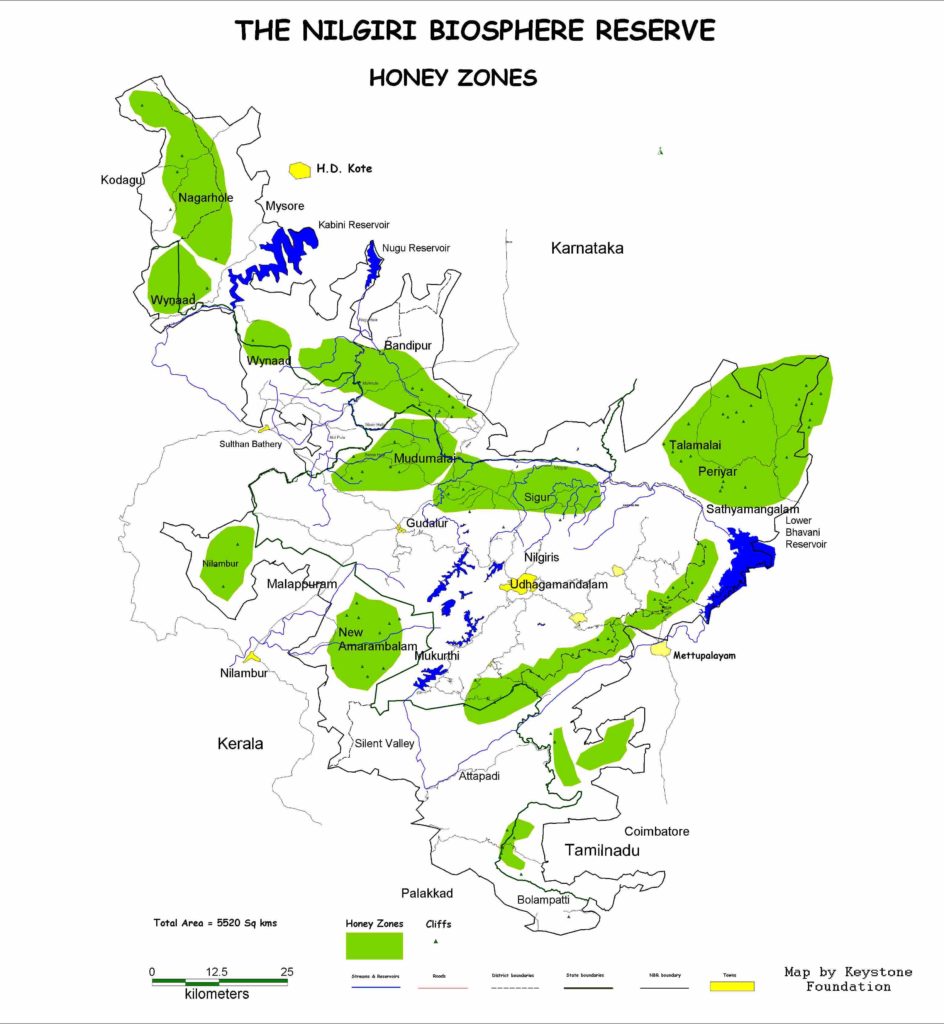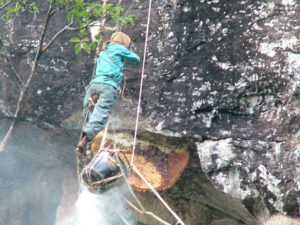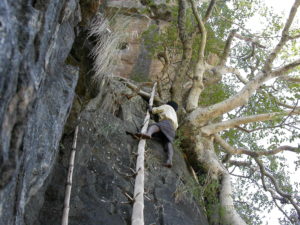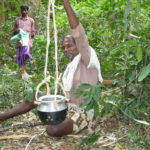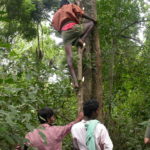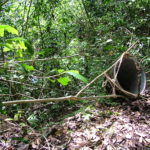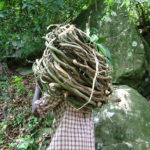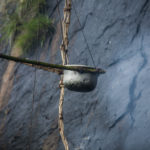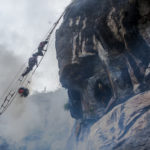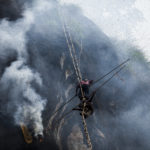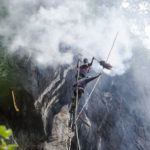Honey Collection Method
The Nilgiri Biosphere Reserve is comprised of the Blue Mountains and home to numerous unique features, the practice of honey hunting being one of them. The handful of indigenous people groups who partake in this ancient tradition have developed unique methods and materials best suited for both honey collection from cliff overhangs and large trees. This tradition is found among multiple tribes (ex: Kurumbas, Irulas, Sholigas, Todas) and some tribes have honey collection methods unique to their communities (i.e. Todas utilizing only their breath to move bees from a hive instead of irritants like smoke). This ancient practice goes back many generations, even thousands of years with various rock paintings depicting the antiquity of this practice, such as those from Andra Pradesh that date back to 6000 years ago. And even in the midst of the change of time and the exponential movement of modernization, much of the aspects of the honey hunting tradition remain steadfast.
The honey hunting season is often between the months of April to June, and can start as early as March depending on the abundance of flowering plants and rains that happened months prior. Sometimes during the months of October to November a smaller honey collection season is possible, yet honey combs are much less and few people will go for this collection. Honey hunters will go to the forest months before for the main collection season and scout out colonies. Once a hive is found they will mark the area with a sign or place herbs near the comb that irritate the bees, and the bees will not be calmed until the herbs are removed by those who have returned to start the hunt. Signs help to ward off unwanted visitors and alert others that the hive had already been claimed. For weeks leading up to the honey collection session, a honey hunter will continue to check the hive and discern if it has matured. Unless the cells of a comb are capped and the moisture is at a certain level, honey hunters will continue to wait for the hive to mature. They also rely on other natural signs, such as withered flowers, which indicates the bees have finished collecting pollen and nectar, and the honey comb should soon be ready for harvest.
A honey hunt, either from a cliff or tree, will begin with rituals and ceremonies. First a group is designated for the honey collection endeavor. In some cases, honey hunting is done alone but it is more common for this work to be done in groups of two or more, and group size is often correlated to how difficult a honey hunt will be. A group will most likely consist of members of the same village, and more so of the same family. This is especially the case for the few tribes who scale cliffs, like the Kurumbas, and take great care in choosing those in their honey hunting group. Individuals will have different tasks or play different roles, such as: tending the fire below, collecting wax and bits of honey comb that is dropped to the ground, and holding the ropes at the top of the cliff that is tied to the basket and smoker. Once there are a few weeks left before the start of a season, the honey hunters will start participating in fasting rituals, prayers, and daily bathing as a respect regiment towards this practice. There is also great acknowledgment towards the gods these communities worship, with the belief if they don’t ask for blessings or if the gods are angered then the honey hunt will be unsuccessful.
Leaving to the forest for the physical honey hunt typically begins in the morning in order to have time to prep certain tools for the process. There are several tools that are required for honey collection, some of which are brought from the village while others are made in the forest prior to the night of the honey hunt. Mostly, the only items brought in are a sharp cutting knife for making the forest tools, as well as a filter and tins pans to collect the honey (this does not consider the items such as food and sleeping mats for while staying in the forest). Some of the main items that are made from the forest are a bamboo pole, basket, and sturdy rope made of either tree bark or bamboo. The necessary tools and number of tools also varies between whether the gathering takes places on a tree or cliff.
When having to climb a tree a bamboo pole/ladder is often used. One bamboo with foot sized sprouts on either side will be set against and tied to a tree for climbing or small steps may be cut into the trunk of the tree. If a rope ladder is used it is made with various climber such as the lianas found on tree bark. In some cases people will simply climb the tree bare foot, not using any tools for support. Additionally, coir rope is used to help with climbing towards the branch where the honeycomb is attached. The tool used to cut the comb down will either be an iron or wooden knife, with the wooden version more often being used by the Sholigas. Sometimes a knife made of bamboo will be used. Once a comb is cut down the honey portion will be collected into containers by teammates on the ground below.
In regards to tree collection, it can be handled with a minimum of 2 people, yet more than 2 will likely be found in a group. Comparatively, honey collection from cliffs requires a long rope to be made in the shape of a ladder because it will be tied to a tree at the top of the cliff and then lowered down the cliff face, some of which can be 400-500 feet in height. The ropes made, from a few days prior, will be constructed of either the stripped bark of a tree or the lianas/vines found on the tree. The bark made rope can last up 7 years while the vine rope is only useful for a season. Some of the species of wild climber and bark of trees include Vakka (Sterculia villos), Biskoti kodi (Derris benthamii) and Ullathi (Debregeasia longifolia). Multiple ropes will be prepared in order to serve different purposes (i.e. ladder for a honey hunter to climb, what attaches to other tools like smoker).
Another crucial tool is the honey basket – its purpose is to catch the honey and honey comb portions after the honey hunters have cut the main comb. This basket is constructed in the forest and made out of vines, bamboo, as well as cane. The inner part of the basket is then covered with leaves from the Cucuma spp. and recently, in some cases, has alternatively been lined with plastic. The making of the basket is often done in the evening before the night of the honey hunt. These days oil tins and aluminum vessels might be substituted the forest woven baskets as a means of convenience.
Honey hunters rarely have protective gear on when they go to collect honey, even when dangling from a cliff a few hundred feet in the air. The only source of protection they use is a smoker, which is a bundle of specific leaves with dry twigs inside that dangles near the honey hunter as he hangs from the rope parallel to the cliff or is held by the person balancing on top of a branch when collecting from a tree. The purpose of the smoker is to remove the bees from the comb before the honey is collected. Years ago people used to directly touch the comb with the burning bundle, ultimately killing numerous bees in that hive. However, today people mostly smoke out the bees so that they abscond the nest and are left unharmed. Certain plants are selected that which are ideal for the smoker, such as: Strobilanthus spp. Cassia fistula are used in Nilambur and, Lantana, Eupatorium, Pongamia pinnata, Syzigium spp in Chamarajnagar.
This process of cliff collection goes as such: a honey hunter will climb down the cliff via the rope tied atop and most likely secured by the brother-in-law. Others will then lower down ropes attached to a smoker, bamboo spear, and a basket. With the spear he will jab at the large comb until the majority brood portion falls to the ground, which will be collected by his teammates below. Afterwards he will balance the basket under the remaining honey portion left in tact to the cliff and while he cuts thick flows of honey and chunks of honeycomb will fall into the basket, which will be pulled up and collected by those at the top pf the cliff once the basket is full. This process can take up to two hours for a single large hive and therefore several days when collecting from several colonies. The large hive and bee colonies found on cliffs are solely from the species Apis dorsata, and the honey collection will start at night around 6:30 p.m. and is able to last until 5:30 a.m. depending on the number of combs on a cliff. This is in contrast to honey collected from the other three honey bee species (Apis cerana, Apis florea, and Dammer bees), which can be hunted during the day given their temperament is more docile than the Giant Rock Bee.
The experience of honey hunting from the cliffs, especially when collecting honey from the temperamental Giant Rock Bee, is a really difficult task. It must be done with a group, each individual having a designated task, and often involves great trust. One such task is the role of the man at the top of the cliff who makes sure the rope holding the man dangling upon it and jabbing the hive for honey is secure. A tradition among the tribes who collect from cliffs is to always have the brother-in-law holding/keeping track of the rope of the man dangling from it. The idea is that if the man up top slacks in his job (or decides to be vindictive) and the rope falls, then the man will fall to his death, which also means the rope holder (brother-in-law) will have made his sister a widow. A very unique tradition as a means to maintain alertness and carefulness.
Much of these methods have been maintained for generations, in conjunction to the relationship with the forest and it’s honey that they have adapted their skills too. Over time, changes have been made here and there but the ultimate task has remained steadfast. Time will tell if the overall tradition of honey hunting remains as well. Keystone Foundation is an organization that invests greatly in the multitude of Nilgiri tribes and one way of supporting these groups is by making sure the forest is accessible for them to continue their ancestral traditions, such as helping enforce the Forest Rights Act.
